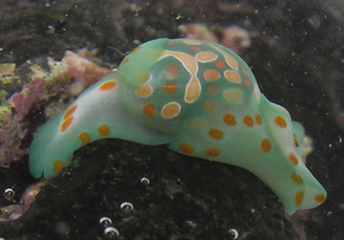This species has been observed on Reunion, Mauritius, Mayotte and Rodrigues Islands
It is characterised by the bright orange spots and diffuse purple markings (sometimes absent) on the translucent greenish body. The two black spots corresponded to the eyes. |

|
|
| Showing species characteristics... | Photo Philibert Bidgrain |
|
See more about : Sightening and mating periods
See more about : H. cymbalum, great mass spawning event in Saint gilles lagoon
See more about : Haminoea cymbalum, broken shell expulsion...
See more about : Haminoea cymbalum variability in Southwest Indian ocean
Remarks :
Identification confirmed by Bill Rudman
In Reunion island this species are observed in large aggregation by Maurice Jay ("Cap la Houssaye" at Saint Paul) and by Philibert Bidgrain (October-November 2005 at Etang salé les bains).
During a few days, in February 2007, we observed in the lagoon of Saint Gilles, just near the beach, a great mass spawning event.
In February-March 2010, I observed on La Saline lagoon, a importante population (about one hundred animals) of Haminoea cymbalum and a few spawn.
Synonymous : (according Worms)
- Bulla cymbalum Quoy & Gaimard, 1832 - Haminoea similiana Pease, 1868
- Haminoea cymbalum (Quoy & Gaimard, 1832) - Lamprohaminoea cymbalum (Quoy & Gaimard, 1832)
Bibliographic data :
Uncommun, but when found it is usually in large aggregations down to 20 m of water
It seems to vary in colour quite considerably, some animals having no purple, others with small purple spots, and others with large diffuse purple patches. The orange and green also varies.
A molecule ( kumepaloxane), produced by the slug, is perhaps an antifeedant chemical which makes the slug distasteful to predators.
According to C.Carlson, Haminoea cymbalum has been fairly consistent in its color pattern, and it is easily separable from the other orange spotted species by the nature of it's gizzard plates, shell shape as well as color. He considers that there exist four other orange spotted species ( see C.Carlson & PJ.Hoff in Sea Slug Forum )
They are herbivores, feeding almost exclusively on filamentous algae.
Presence of an internal shell (see below Maurice Jay's photo). In some case, the green on the shell is caused by a fine layer of microscopic green algae, and mall tufts of filamentous algae are also growing on the the shell (see below Philibert Bidgrain's photo)
References :
Bill Rudman Seaslug site : Sea Slug Forum : Haminoea cymbalum
Nudipixel Haminoea cymbalum
Publications :
Drivas, J.; Jay, M. (1987). Coquillages de La Réunion et de l'Île Maurice. Collection Les Beautés de la Nature. Delachaux et Niestlé: Neuchâtel. ISBN 2-603-00654-1. 159 pp
Rudman,W.B.,1971. Structure and functioning of the gut in the Bullomorpha (Opisthobranchia). Part 1. Herbivores. Journal of Natural History, 5 : 647-675.
Rudman,W.B.,1971. On the opisthobranch genus Haminoea Turton & Kingston. Pacific Science, 25 : 545-559.
Other photos of Haminoea cymbalum :
Shell structure and external appearence. |
||
Maurice Jay Smooth shell, maximun lengh : 14,5 mm |
Philibert Bidgrain. In this case, the green on the shell is caused by a fine layer of microscopic green algae, and small tufts of filamentous algae are also growing on the the shell. |
|
 |
|
Pattern modification during Haminoea growth : Philibert Bidgrain. The two photo are taken from animal observed in the same homogenous population observed in Etang salé les bains in October-November 2005. |
|
Reunion, 2 October 2005, size 10-15 mm, |
Reunion, 30 October 2005, size : 25 mm |
 |

|
Trailing behaviour. Philibert Bidgrain. Etang salé les bains, |
 |
 |
Philibert Bidgrain Reunion, Etang salé les bains, 2 October 2005. The black spot is the eye. Quite a few species, like H.cymbalum, have a semitransparent or translucent patch above each of the eyes so some light can get through. Some animals have large diffuse purple patches |
Philibert Bidgrain Reunion, La saline lagoon, less 1 m, 23 December 2008, size : 18 mm
This animal has numerous purple spots
|
 |
 |
Philibert Bidgrain Reunion, La saline lagoon, less 1 m, 25 February 2010, size : 15 mm Important population observed, about 100 animals, often showing behavior of "trailing" from 2 to 4 individuals. |

Each spawn consists in a jelly-like tube on whose surface a long chain of white egg mass can be observed |
 |
Geoffrey Summers Mauritius, Pointe d'Esny lagoon, December 2015
|
.jpg) |
 |
Remy Eudeline Mayotte, Bouée de l'îlot d'Hajangoua, 4 m, 29 avril 2018
|
More photos from Indian Ocean
See more about : H. cymbalum, great mass spawning event in Saint gilles lagoon
See more about : Haminoea cymbalum, broken shell expulsion...
See more about : Haminoea cymbalum variability in Southwest Indian ocean
Reunion, Haminoea cymbalum, at Saint Paul, by David Caron
Reunion, aggregation of Haminoea cymbalum, at La Saline, by Christophe Cadet
Reunion, H. cymbalum on a sponge, at Saint Gilles, by Guillaume Boeye
Reunion, trailing with a baby Haminoea cymbalum, at Etang salé, by Philibert Bidgrain
Reunion, three Haminoea cymbalum, at Etang salé, by Philibert Bidgrain
Rodrigues, a pair of Haminoea cymbalum, by Juliette Larrosa
